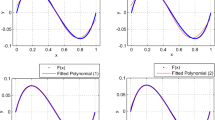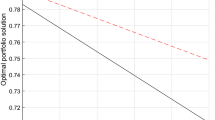Abstract
Since the financial markets are complex, sometimes the future security returns are represented mainly based on experts’ judgments. This paper discusses a portfolio adjusting problem with risky assets in which security returns are given subject to experts’ estimations. Here, we propose uncertain mean-semiabsolute deviation adjusting models for portfolio optimization problem in the trade-off between risk and return on investment. Various uncertainty distributions of the security returns based on experts’ evaluations are used to convert the proposed models into equivalent deterministic forms. Finally, numerical examples with synthetic uncertain returns are illustrated to demonstrate the effectiveness of the proposed models and the influence of transaction cost in portfolio selection.

Similar content being viewed by others
References
Arnott RD, Wagner WH (1990) The measurement and control of trading costs. Financ Anal J 46(6):73–80
Baule R (2010) Optimal portfolio selection for the small investor considering risk and transaction costs. OR Spectr 32:61–76
Bertsimas D, Pachamanova D (2008) Robust multiperiod portfolio management in the presence of transaction costs. Comput Oper Res 35:3–17
Chen X, Liu Y, Ralescu DA (2013) Uncertain stock model with periodic dividends. Fuzzy Optim Decis Mak 12(1):111–123
Choi UJ, Jang B, Koo H (2007) An algorithm for optimal portfolio selection problem with transaction costs and random lifetimes. Appl Math Comput 191(1):239–252
Fang Y, Lai K, Wang S (2006) Portfolio rebalancing model with transaction costs based on fuzzy decision theory. Eur J Oper Res 175(2):879–893
Gao Y (2011) Shortest path problem with uncertain arc lengths. Comput Math Appl 62(6):2591–2600
Glen JJ (2011) Mean-variance portfolio rebalancing with transaction costs and funding changes. J Oper Res Soc 62:667–676
Huang X (2011) Mean-risk model for uncertain portfolio selection. Fuzzy Optim Decis Mak 10:71–89
Huang X, Qiao L (2012) A risk index models for multi-period uncertain portfolio selection. Inf Sci 217:108–116
Huang X, Ying H (2013) Risk index based models for portfolio adjusting problem with returns subject to experts evaluations. Econ Model 30:61–66
Konno H, Yamazaki H (1991) Mean absolute portfolio optimisation model and its application to Tokyo stock market. Manag Sci 37(5):519–531
Lee W, Yu J (2011) Portfolio rebalancing model using multiple criteria. Eur J Oper Res 209(2):166–175
Li X, Qin Z (2014) Interval portfolio selection models within the framework of uncertainity theory. Econ Model 41(1):338–344
Li S, Peng J, Zhang B (2013) The uncertain premium principle based on the distortion function. Insur Math Econ 53:317–324
Liu B (2007) Uncertainity theory, 2nd edn. Springer, Berlin
Liu B (2010) Uncertainty theory: a branch of mathematics for modeling human uncertainty, 3rd edn. Springer, Berlin
Liu Y, Qin Z (2012) Mean semi-absolute deviation model for uncertain portfolio optimization problem. J Uncertain Syst 6(4):299–307
Lobo MS, Fazel M, Boyd S (2007) Portfolio optimization with linear and fixed transaction costs. Ann Oper Res 152:341–365
Markowitz H (1993) Computation of mean-semivariance efficient sets by the critical line algorithm. Ann Oper Res 45:307–317
Markowitz H (1952) Portfolio selection. J Financ 7:77–91
Morton AJ, Pliska SR (1995) Optimal portfolio management with transaction costs. Math Financ 5(4):337–356
Ning Y, Liu J, Yan L (2013) Uncertain aggregate production planning. Soft Comput 17(4):617–624
Patel N, Subrahmanyam M (1982) A simple algorithm for optimal portfolio selection with fixed transaction costs. Manag Sci 28(3):303–314
Qin Z, Kar S (2013) Single-period inventory problem under uncertain environment. Appl Math Comput 219(18):9630–9638
Qin Z, Kar S, Li X (2009) Developments of mean-variance model for portfolio selection in uncertain environment. http://orsc.edu.cn/online/090511
Simaan Y (1997) Estimation risk in portfolio selection: the mean variance model and the mean-absolute deviation model. Manag Sci 43:1437–1446
Speranza MG (1993) Linear programming model for portfolio optimization. Finance 14:107–123
Wen M, Qin Z, Kang R (2014) The \(\alpha \)-cost minimization model for capacitated facility location-allocation problem with uncertain demands. Fuzzy Optim Decis Mak 13:345–356
Wen M, Qin Z, Yang Y (2014) Sensitivity and stability analysis of the additive model in uncertain data envelopment analysis. Soft Comput. doi:10.1007/s00500-014-1385-7 (In press)
Yao K, Ji X (2014) Uncertain decision making and its application to portfolio selection problem. Int J Uncertain Fuzziness Knowl Based Syst 22(1):113–123
Yoshimoto A (1996) The mean-variance approach to portfolio optimization subject to transaction costs. J Oper Res Soc Jpn 39(1):99–117
Zhang W, Zhang X, Chen Y (2011) Portfolio adjusting optimization with added assets and transaction costs based on credibility measures. Insur Math Econ 49:353–360
Zhu Y (2010) Uncertain optimal control with application to a portfolio selection model. Cybern Syst 41(7):535–547
Acknowledgments
This work was supported in part by National Natural Science Foundation of China (Nos. 71371019 and 71371021), and in part by the Program for New Century Excellent Talents in University (No. NCET-12-0026).
Author information
Authors and Affiliations
Corresponding author
Additional information
Communicated by V. Loia.
Appendix
Appendix
Proof of Theorem 1
Note that \(\sum _{i=1}^n\xi _ix_i\) is also an uncertain variable. It immediately follows from Lemmas 1 and 3 of Sect. 2 that the theorem holds.
Proof of Theorem 2
Assume that there exists \(k\in \{1,2,\ldots ,n\}\) such that \(\hat{x}_k^+>0\) and \(\hat{x}_k^->0\). Without loss of generality, it is assumed that \(\hat{x}_k^+ > \hat{x}_k^-\). The optimal holding quantity of security \(i\) after adjusting is \(\hat{x}_k=x_k^0+\hat{x}_k^+-\hat{x}_k^-\). We set \(\tilde{x}_k^+=\hat{x}_k^+-\hat{x}_k^-\) and \(\tilde{x}_k^-=0\). It is evident that \(\tilde{x}_k^+\cdot \tilde{x}_k^-=0\), \(\tilde{x}_k^+,\tilde{x}_k^-\ge 0\) and \(\tilde{x}_k=x_k^0+\tilde{x}_k^+-\tilde{x}_k^-=\hat{x}_k\) which implies that \((\hat{x}_1^+,\ldots ,\hat{x}_{k-1}^+,\tilde{x}_k^+,\hat{x}_{k+1}^+,\ldots ,\hat{x}_n^+, \hat{x}_1^-,\ldots ,\hat{x}_{k-1}^-,\tilde{x}_k^-,\hat{x}_{k+1}^-,\ldots ,\hat{x}_n^-)\) is a feasible solution of Model (8). Note that
which means that \(E[r(\hat{x}_1,\ldots ,\hat{x}_{k-1},\tilde{x}_k,\hat{x}_{k+1},\ldots ,\hat{x}_n)] >E[r(\hat{x}_1,\ldots ,\hat{x}_{k-1},\hat{x}_k,\hat{x}_{k+1},\ldots ,\hat{x}_n)]\). In addition, since \(\tilde{x}_k=\hat{x}_k\), the return on the portfolio \((\hat{x}_1,\ldots ,\hat{x}_{k-1},\tilde{x}_k,\hat{x}_{k+1},\ldots ,\hat{x}_n)\) has the same semiabsolute deviation as that on the portfolio \((\hat{x}_1,\ldots ,\hat{x}_{k-1},\hat{x}_k,\hat{x}_{k+1},\ldots ,\hat{x}_n)\). Therefore, it is in contradiction to that \((\hat{x}_1^+,\ldots ,\hat{x}_n^+,\hat{x}_1^-,\ldots ,\hat{x}_n^-)\) is Pareto optimal. The theorem is completed.
Proof of Theorem 3
It follows from the operational law of uncertain variables that the portfolio return \(\sum _{i=1}^n\xi _ix_i =(\sum _{i=1}^nx_ic_i,\sum _{i=1}^nx_id_i)\) is also a linear uncertain variable with expected value \(\sum _{i=1}^nx_i(d_i+c_i)/2\). Further, we have
Therefore, the second objective is equivalent to maximize the term in parentheses on the right-hand side of the above equation. In addition, it follows from Liu and Qin (2012) that
Note that since \(x_i\ge 0\) and \(d_i>c_i\) for \(i=1,2,\ldots ,n\), we have \(\sum _{i=1}^nx_i(d_i-c_i)\ge 0\) which implies that the first objective is equivalent to minimize it. The theorem is proved.
Proof of Theorem 4
It follows that the portfolio return
is also a zigzag uncertain variable. According to the definition of expected value, we have \(E[\sum _{i=1}^n\xi _ix_i]=\sum _{i=1}^nx_i(4a_i+\beta _i-\alpha _i)/4\) which implies that the second objective is equivalent to maximize \(\sum _{i=1}^nx_i(4a_i+\beta _i-\alpha _i)-4\sum _{i=1}^n(b_ix_i^++s_ix_i^-)\). Further, by the definition of semiabsolute deviation of uncertain variable, it is obtained that
Substituting the semiabsolute deviation of the portfolio return into the first objective, the theorem is proved.
Proof of Theorem 5
It follows from the operational law of normal uncertain variables that the portfolio return \(\sum _{i=1}^n\xi _ix_i\sim \mathcal {N}(\sum _{i=1}^nx_ie_i,\) \(\sum _{i=1}^nx_i\sigma _i)\) is also a normal uncertain variable. Further, it follows from the definitions of expected value and semiabsolute deviation of uncertain variables that
in which non-negativity holds due to non-negativity of \(x_i,e_i\) and \(\sigma _i\) for \(i=1,2,\ldots ,n\). Substituting them into the two objective functions in Model (9), the theorem is proved.
Proof of Theorem 6
The second objective holds since \(E[\xi _i]=\int _0^1\Phi _i^{-1}(\alpha )\mathrm{d}\alpha \) for \(i=1,2,\ldots ,n\) by Lemma 1. According to the definition of semiabsolute deviation of uncertain variable, we have
Note that since \(x_i\ge 0\) for \(i=1,2,\ldots ,n\), it follows from the operational law (Liu 2010) that \(\xi _1x_1+\xi _2x_2\cdots +\xi _nx_n\) has an inverse uncertainty distribution \(\Psi _1^{-1}(\alpha ) = x_1\Phi _1^{-1}(\alpha )+x_2\Phi _2^{-1}(\alpha )\cdots +x_n\Phi _n^{-1}(\alpha )\). For any given r, the value of \(\Psi (r)=M\{\xi _1x_1+\cdots +\xi _nx_n\le r\}\) is just the root of the equation \(\Psi _1^{-1}(\alpha ) = r\), i.e., \(x_1\Phi _1^{-1}(\alpha )+\cdots +x_n\Phi _n^{-1}(\alpha )=r\). Substituting it into the expression of \(Sa[\xi _1x_1+\xi _2x_2\cdots +\xi _nx_n]\), the first objective function is obtained. The theorem is proved.
Rights and permissions
About this article
Cite this article
Qin, Z., Kar, S. & Zheng, H. Uncertain portfolio adjusting model using semiabsolute deviation. Soft Comput 20, 717–725 (2016). https://doi.org/10.1007/s00500-014-1535-y
Published:
Issue Date:
DOI: https://doi.org/10.1007/s00500-014-1535-y




